
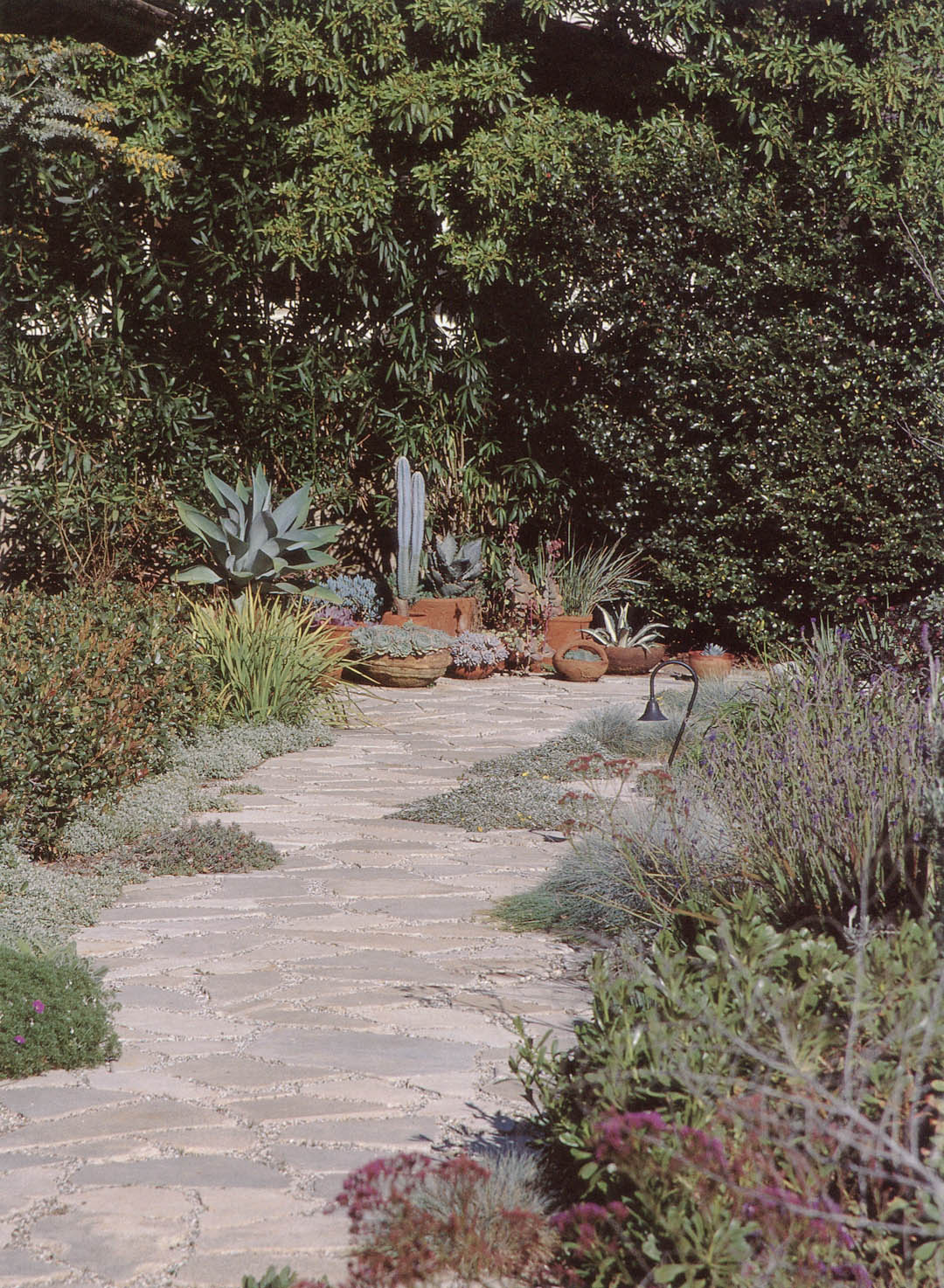
Contributor
- Topics: Archive, Inspired Gardens and Design
… what defines a garden is less what is grown in it than how what grows is arranged.
Joe Eck, Elements of Garden Design
One of the particularly satisfying things about designing gardens for other people is that, in most instances, I get to consider the project as a whole, from the beginning. I can plan the overall structure, the hardscape and the planting as a more or less coherent design; manage the construction; and plant it as a continuous, if sometimes rather drawn out, process. Then I can stand back, imagine how it will look when the plants are grown up, admire what we have done, dust off my hands, and move on to the next project.
That can be really gratifying and produces good art and wonderful gardens, but it does mean that, as a garden designer, I seldom create a garden for others in the way we gardeners tend to make them for ourselves. For various reasons we tend to build them in stages, with time to consider the successes or failures and, ideally, with each new part growing from, and informed by, what we have already done. This does not mean the design is lacking an overall plan—it can be strongly structured—or that the gardener has no clear idea of where the design is headed. Living with a site, however, gives the gardener an intimate knowledge of it—seeing it in all weathers and all lights—and the time to make adjustments to accommodate new ideas, new information, and new plants. And it means the focus on individual elements can be more intense. This might be why I find most compelling gardens that have been created by their owners.
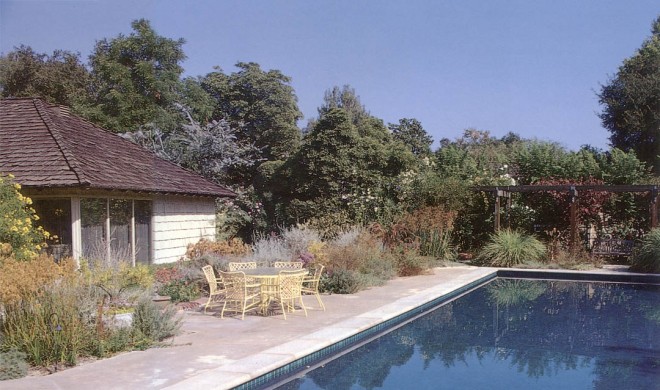
A Pasadena Garden
Sometimes, though, I do get to create a garden in stages for somebody else, and that is how the Pasadena garden I designed for Cynthia Hall was developed, or more accurately, redeveloped. Her one-acre lot, parceled off from one of the huge old estates of the area, includes a tennis court and swimming pool; a ranch-style house was tucked in between them at the end of a gently curving concrete drive—very much the informal outdoor-oriented house of the mid-twentieth century. For the purposes of garden design, the pool and tennis court were givens, as they were well used by the family, but Mrs Hall had begun to question the value and appropriateness of the vast stretches of lawn dotted with elderly fruit trees and little beds of annuals—the legacy of various former gardeners. There was also the matter of her growing interest in gardening and her rapidly increasing collection of plants that were getting squeezed in wherever there was a possibility, or were sitting around in pots where there was not. So I was contacted, and challenged to plan a garden that would be more interesting, would offer homes for a great variety of plants, and would be beautiful as well.
We started the transformation with a relatively small, contained area between the house and tennis court, a wide grass path with narrow beds on either side leading to a beautiful pink crape myrtle (Lagerstroemia indica). Mrs Hall thought the grass could be replaced with a path of broken concrete “crazy paving,” as she had seen in another garden I had done, and the beds could be a little wider. It was a good beginning. The planting beds became a good deal wider, but there was still room for a generous path, broad enough to let the plants spill well over the edges; the path led to a circle of the same crazy paving and a seat beneath the crape myrtle. Large concrete pots, placed just off the path in the planting area, provided focal points and an opportunity to grow accent plants that might be lost in the ground level beds.
When we came to the plant selections, the crape myrtle at the center of the design took second place to a nearby kumquat, whose brightly colored, year-round fruits became the keynote for a mixed border of yellows and oranges, with a few pinks and light purples to set them off—all the shades I think of as “sherbet colors.” To make the shady circle around the crape myrtle seem like a just reward for walking down the path, we used a collection of abutilons for a backdrop; pots of reed-stem orchids (Epidendrum), along with gold-leafed and variegated plants help make the circle as interesting as the more flowery approach (a balancing act accomplished elsewhere in the garden with silver-variegated plants). Hedera ‘Gold Child’ makes a scintillating ground cover for bulbs and perennials, while Duranta repens ’Variegata’ becomes a fountain of showy, white-edged leaves and blue flowers followed by golden fruits. An exception to the golden theme, and one of my very favorite plants, is a purple-leafed Eupatorium sordidum enriching the mix.
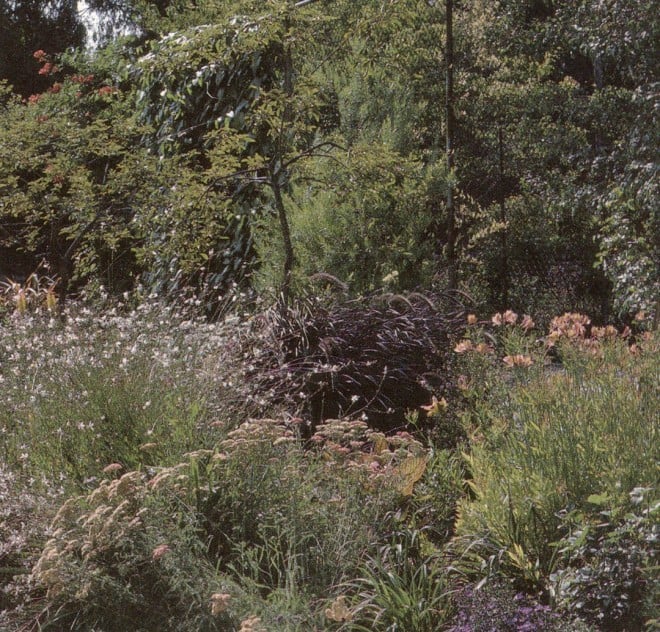
The tennis court fence, an erstwhile eyesore, became a wall of climbing roses and sky-blue Thunbergia grandiflora (which is performing almost too well). In the sunny bed in front of it, a golden trumpet tree (Tabaebuia chrysotrichia) adds another layer of color to the alstroemerias, kniphofias and daylilies below. On the other side of the path, the bed against the house was planted with flowering shrubs to create a bit more shade and dignity. The beautiful foliage and solid mass of Mahonia bealii and Osmanthius ilicifolius ‘Variegatus’ are set off by the perpetually flowering Justicia brandegeana ‘Chartreuse’, a plant whose yellow-green flowers enhance any other color. Both beds have room for small bulbs and annuals to maintain the color through the year.
While we dug and re-organized plants from the existing borders, planted out ones that had been in pots, and brought in many more, it became clear that everybody liked the result. Yet we still had more plants than we had places for—and expanses of lawn with floral bulls-eyes dotted around them. We decided to remove all of the lawn between the tennis court and the driveway, replacing it with a more gracious approach to the tennis court and its little pavilion, and, of course, creating a more generous planting area.
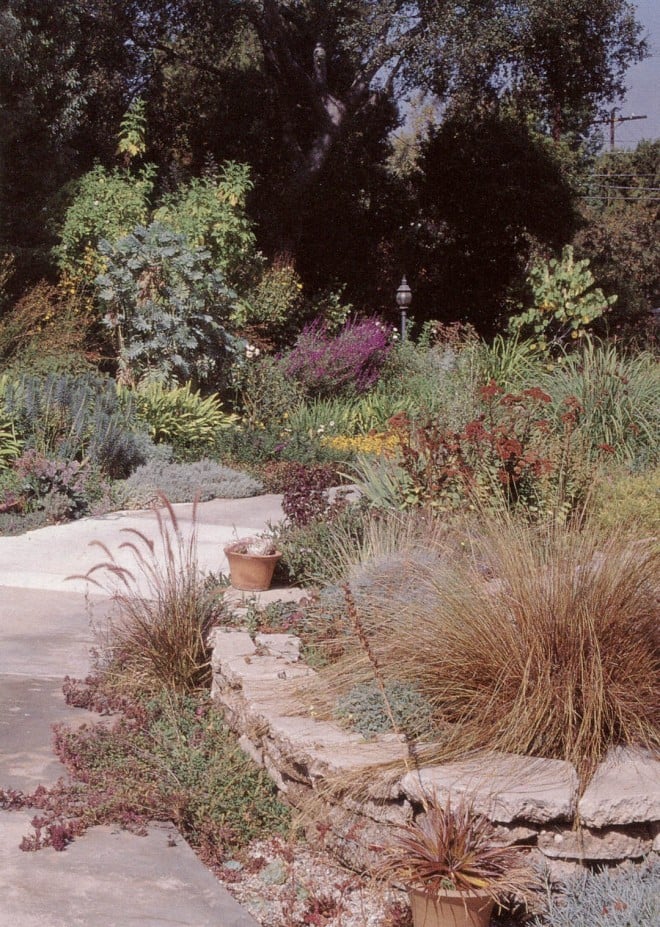
Adding a Little Height
I designed a raised bed of dry-stacked broken concrete in low walls curving along the edge of the drive, partly to add variety to a flat landscape and to provide enclosure without hiding the new garden, but also to give us a place to grow small bulbs and other plants that would need good drainage and close attention—our version of a rock garden. The broad top of this wall also serves as a seat from which to enjoy the garden and the meandering patio that grew out of the path. Because this walkway is intended for access as much as entertainment, I used square, stabilized adobe pavers for a smoother, more solid surface than the broken concrete used elsewhere. The path has a pleasantly informal look, and because every journey should have its rewards, there is a bench and a cluster of pots filled with succulents at the end of this walkway, just before the gate to the tennis court. There you can sit and enjoy one of my favorite sights in the garden: the shining, silver sword-like leaves of Astelia chathamica, surrounded by the yellow-leafed selection of lamb’s ears (Stachys byzantina ‘Primrose Heron’). Beyond this seat, the raised planter curls around the tennis pavilion, now nestled in a bed of mediterranean plants. Just beyond, a garden featuring grasses makes a graceful transition to the driveway gate.
The grasses are the first things you see upon entering the property, after a glorious fanfare from the golden trumpets of Brugmansia ‘Charles Grimaldi’ that hangs over the fence; the grasses seem to catch the light at any time of day. The rich tones of purple Pennisetum setaceum ‘Cupreum’ blend with mahogany daylilies, Sedum ‘Autumn Joy’, and silver-striped Miscanthus sinensis ‘Morning Light’; the glossy puffs of Mexican feather grass (Stipa tenuissima) add a delicate brilliance. When leaving the garden, a golden fountain of Cortaderia ‘Gilt Edge’ is the focus, surrounded by rosemary and Salvia clevelandii, placed so the gate will brush against it releasing the sweet fragrance of its foliage as you come and go.
No More Lawn
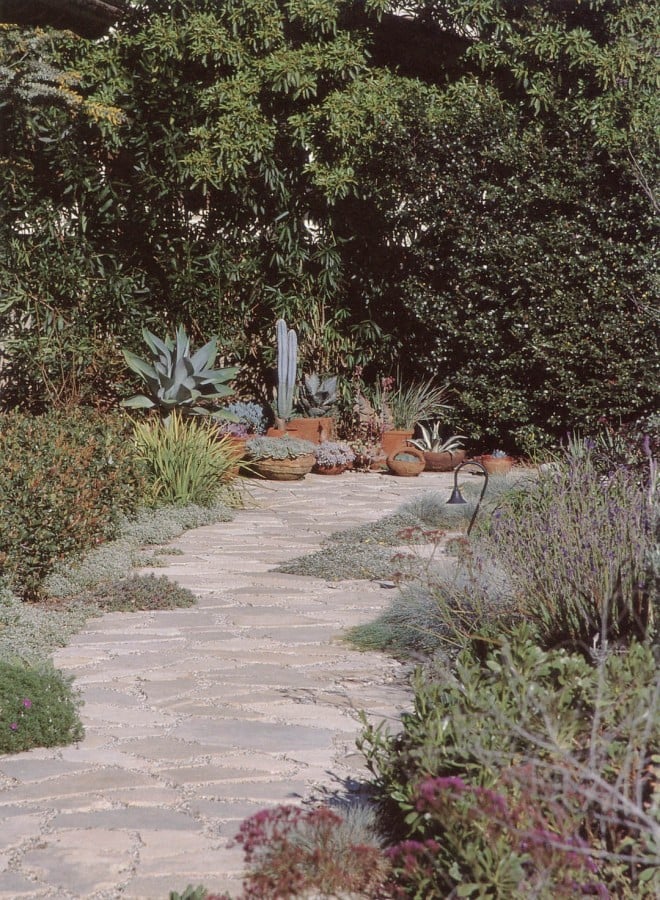
At this point, we had completely transformed the garden space on the east side of the driveway (along the tennis court) into what is, in effect, an expanse of mixed border with pathways leading through it. Clearly, it was a condensed version of the way Mrs Hall and I were now visualizing the entire garden: a series of passageways through exuberant plantings, where small patios were the rewards for wandering down narrow paths, while the larger paths led to functional things like the tennis court, the swimming pool, and the house. It would be a “paradise garden” where the breathing space usually provided by a lawn would be created by the paving and the pool. With this in mind we clearly had to deal with the other side of our primary passageway, the driveway.
And so we eliminated another lawn and a great number of agapanthus, and planted it instead with a variety of perennials and shrubs. Unlike the predominately mediterranean-climate plants on the sunnier side of the drive, this cooler east-facing bed gives us room to use some of the towering asters, perennial sunflowers, and rudbeckias that are out of scale with most residential gardens. To keep this from seeming too claustrophobic, a wide swathe next to the driveway was kept in groundcovers and perennials of reasonably low stature. To give the space a human element and remind you that it is a garden, we added a small paved circle with a table and chairs just opposite the grass garden—a place to enjoy a garden lunch or a brugmansia-scented evening under the native oaks that shelter it.
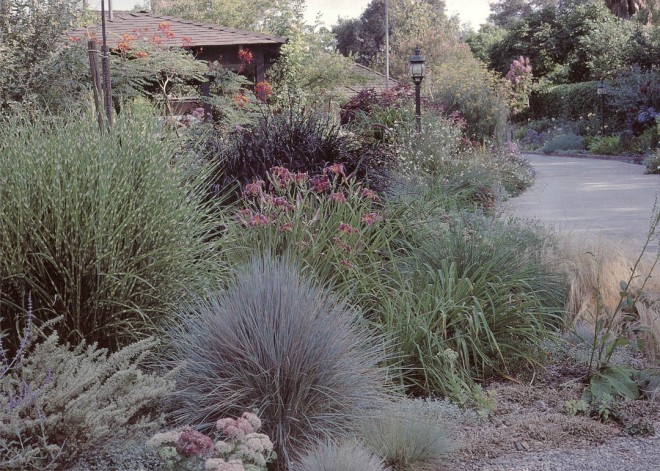
After this, having expunged lawn from the greater part of the garden, Mrs Hall and I took a rest while we worked out designs for our assault on the area around the swimming pool to the rear of the house; here we needed to replace all of the paving as well as the grass. This was done in stages during the following summer, eventually adding a shady pergola for climbing roses, a small raised lily pond to attract birds, and a garden of big concrete pots overflowing with succulents. I left space in the paving under the diving board for a mass of rosemary and other herbs, placed to be near the kitchen and to soften the expanse of pavement around the large swimming pool.
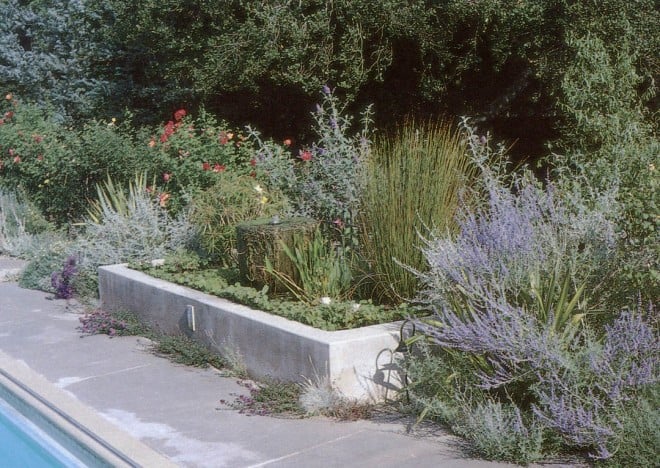
A Third Voice
During these stages of garden development, John C MacGregor IV joined the team as head gardener; with his immense horticultural expertise and experience, John has helped extend the garden themes into even more areas. This means, of course, that the garden is now the province of three people with strong opinions and acquisitive natures, at least horticulturally. John has re-planted and civilized the rose and cutting gardens, and has created a separate garden of the hot colors that were more-or-less excluded from the main beds; it is now one of my favorite bits of the whole complex. He also maintains the seasonal planting and refreshes things as only someone who loves a garden as his own can do.
The last (or at least the most recent) phase has been the remodeling of the pool itself, from a harsh turquoise feature dominating the rear garden into a deep blue asset that changes the light in the entire area into something magical. And that is certainly the way we get around to doing things in our own gardens: the first and most obvious things are often the last to be done.
There is still the question of the massive and glorious oak—a remnant of the old estate that serves as our borrowed scenery beyond the pool garden. That land is to be developed, but there seems to be a possibility that the tree and its quarter-acre of land might be acquired. Who knows where that might lead.
Cynthia Hall’s Pasadena garden will be the site of this year’s garden party for those who have made contributions to the Friends of Pacific Horticulture. Donors will receive an invitation to this event in the mail. If you would like to become a donor, please use the tear-out card at the front of this issue.
Share:
Social Media
Garden Futurist Podcast
Most Popular
Videos
Topics
Related Posts

Ground Up Science for Greener Cities with Garden Futurist Dr. Alessandro Ossola
Spring 2023 Listen to the Podcast here. Alessandro Ossola is a scientist who gets very excited about the challenge of climate change allowing for an

Readying Urban Forests for Climate Realities with Garden Futurist Dr. Greg McPherson
Winter 2023 Listen to the Podcast here. “Going from the mow and blow to a more horticulturally knowledgeable approach to maintaining the landscape. And that

Low Maintenance Gardens – Better for Pollinators and People
Autumn 2022 “I come out every day. It’s therapy, my meditation.” Janet’s young garden transformed from overgrown, invasive plants to mostly natives. The dailiness of

Invasive Plants Are Still Being Sold: Preventing Noxious Weeds in Your Landscape
Autumn 2022 With so many beautiful ornamental plant species and cultivars throughout California and the Pacific Northwest, how do you decide which ones to include









Responses